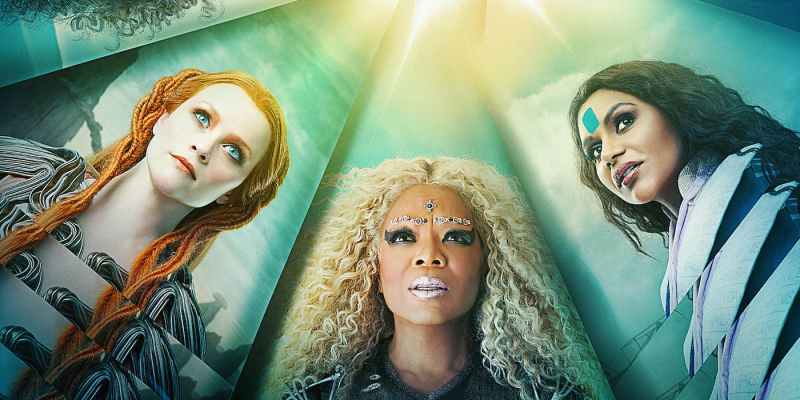This is the first time that I might say that a film is too faithful to the book — that is, the film tries to capture the painted pictures of the bizarre, eerie worlds of “A Wrinkle in Time,” but where the book succeeds is where the film fails. The book allows readers to totally immerse themselves in whatever world they dream up, while the film paints a swirling mess of a shaky CGI-filled world with no purpose other than to attempt to impress the viewer. It tries to capture the broken-up nature of the book, and that’s where the appeal of the novel comes from, but it just doesn’t work as a narrative film, let alone a Disney film.
When I first saw the trailer, I was disappointed to see the film framed as this almost frightening sort of terror dream that sends Meg, Calvin and Charles Wallace spinning into the universe. I don’t know if that’s better or worse than the film (which isn’t particularly scary, except for some smaller parts), which basically feels like a violation of the book, which is precarious in and of itself. Anyone who’s read Madeleine L’Engle’s “A Wrinkle in Time” knows how bizarre the book is — a short, quick read guaranteed to either confuse a child to no end or send them on a spiral into becoming an English major in college.
I was (almost — I’m not quite an English major) both of these cases, as the first time I had read it, I really had no idea what was going on. The choppy narrative, characters dipping in and out with no real backstory (Calvin, for instance) — it’s either a surrealist-lover’s fantasy or some failed attempt at making something out of nothing. But it’s strange enough that it works and has grown into a cherished children’s book.
As a huge lover of films that might be deemed as surrealist, I was excited to see how the worlds of “A Wrinkle in Time” were realized. Outside of the really strange graphics and green screen effects of Mrs. Whatsit (Reese Witherspoon) turning into a large friendly leaf monster (was that in the book?), the worlds are rather masterfully created, though nonetheless rather gratuitous without any narrative supporting them. The film immediately frames itself as a film not just for children, with the cinematography grasping onto anything remotely artistic (I personally enjoyed it) and holding on for dear life as the narrative attempts to cobble itself together. The production design and dialogue attempts (and I use this word very loosely) to make up for what it lacks in story, with Mrs. Which (Oprah Winfrey) and Mrs. Who (Mindy Kaling) providing some comedic backup and flashy costuming. It’s a pleasure to watch, but maybe only in still images — I mean, I’d put those posters up on my wall.
Michael Peña as one of the book’s largest villains, Red, barely appears in one scene, so his character is a one-shot throwaway that only serves to fulfill its purpose in the book, but L’Engle’s function for Red is to serve as this evil force, permitting the reader to imagine him in whatever form they like. Once illustrated on screen, the façade is destroyed, and unfortunately, as fascinatingly performative as Peña is, he’s totally underwhelming.
The final showdown scene between Charles Wallace (Deric McCabe) and Meg Murry (Storm Reid) is also unfortunately too precarious to enjoy. McCabe does a decent job at capturing the particularly “odd” nature (L’Engle makes sure to emphasize this) of Charles Wallace, and Reid makes you fall for Meg in an instant, but Charles Wallace never rises to the demonic nature that is so carefully illustrated in the book — he’s almost too charming (hey, he’s a child). The film also sets up the friendship between Calvin (Levi Miller) and Meg as too close for comfort — an almost too beautiful, pale and skinny white boy who sets his sights on Meg (“I like your hair!”) almost immediately and then keeps getting unnecessarily close to her face, only to back away because — I hope, at least — setting up this romance outside of its implied connotation would make the film even worse. The book’s not about the romance — the book is about love, and “A Wrinkle in Time” tries to capture that in the relationship between Meg’s parents and between Meg and Charles Wallace — even between Calvin and Meg. Nevertheless, it falls short in practically all areas, and the book’s brevity and lack of backstory works, but once you paint a picture onscreen, there’s no taking that back.
I was hopeful that, if anyone, Ava DuVernay could turn the bizarre realities of “A Wrinkle in Time” into a surrealist dreamworld. DuVernay’s pre-film message was that this was a love letter to childhood, but unfortunately, even she couldn’t do the impossible. Maybe some things, like the transcendent realities of “A Wrinkle in Time,” are better left up to the imagination.
Contact Olivia Popp at oliviapopp ‘at’ stanford.edu.
